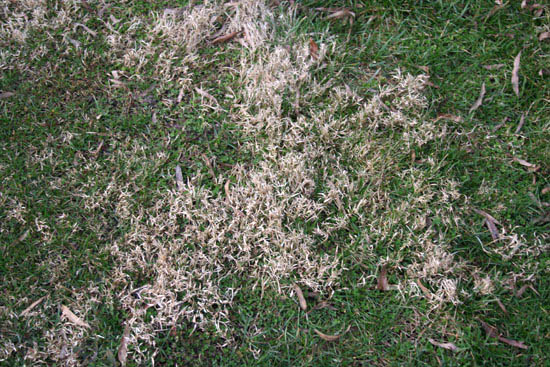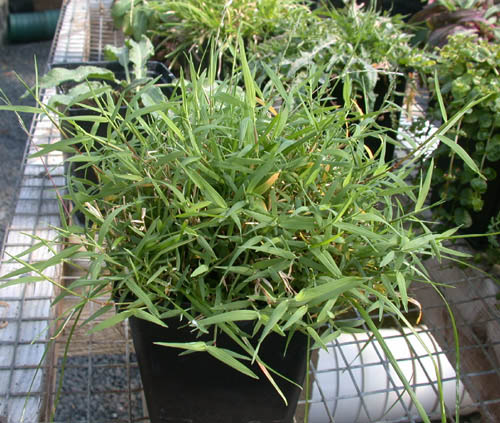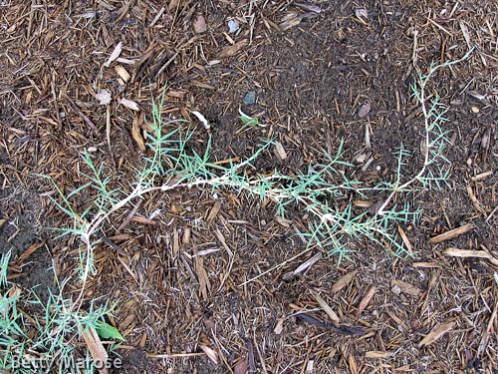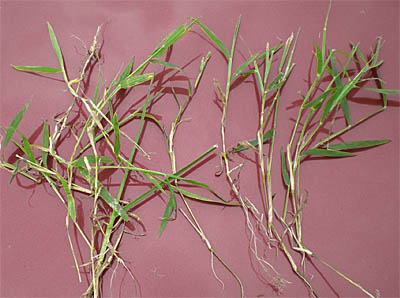Nimblewill — One Tough Lawn Weed
By Barbara Shepard, Fairfax Master Gardener
Did you notice round, straw-colored areas of dead grass in your lawn this past winter? And then did you notice that those same spots turned green when other plants started growing and blooming in spring? If so, your lawn may be plagued with nimblewill, a tough weed to control.
Nimblewill (Muhlenbergia schreberi) is a perennial warm-season grass weed that has a straw-brown appearance during its winter dormancy (from first frost to late spring). During active growth, the color changes to dull blue-green, although some describe it as pale-green or gray-green. Its leaves range in size from 1 to 3 inches, and a quarter-inch wide. It tolerates a variety of soils and conditions and very often grows in shady areas that desirable grasses snub.

Patches of dormant nimblewill in early spring
Nimblewill, a native, is one of our most common grass-weed problems. Other perennial grass weeds in Virginia are bermudagrass, dallisgrass, orchardgrass and quackgrass. According to Professor Shawn Askew, an extension turfgrass weed specialist at Virginia Tech, nimblewill is in every lawn in Virginia. Given that notoriety, nimblewill might also be considered among those weeds hardest to control. Pre-emergent and broadleaf weed herbicides have no effect on the nimblewill that established itself in a prior season.

Nimblewill stems, leaves and seed heads are easy to identify
Nimblewill spreads by seed and aboveground stolons (stems or runners). Although seed heads are formed from midsummer on, growing along a slender spike, the stolons are what give you more of a problem. The stolons — described as very thin and wiry with small, rounded, bead-like nodes — form roots where any node comes in contact with the soil. They then create a spreading patch that can grow 1 to 2 feet in diameter in one year. Left unmown, nimblewill can grow upright to a height of 18 to 24 inches. You can easily pull nimblewill and think it has been handily dispatched. But beware — any piece of root left in the ground will start new growth, and digging, rototilling, aeration and thatching activity may help it spread. However, hand pulling does slow its expansion.

Bermudagrass, also known as wiregrass, resembles nimblewill
Nimblewill closely resembles bermudagrass (Cynodon dacthylon), a turfgrass used for lawns, golf courses and athletic fields across southern Virginia and warmer regions of the U. S. If you are inclined to control nimblewill, make sure you can distinguish it from bermudagrass. Nimblewill’s stolons are slow growing, very thin in diameter, and do not creep more than a few inches from the parent plant. As it spreads, its round patches are sometimes referred to as “pie plates.” Bermudagrass, also called wiregrass, can make round patches, but its creeping stolons are larger, venturing several feet from the parent plant.
If the targeted grass is growing in a shaded area, it is probably nimblewill; bermudagrass does not tolerate shade. But the most distinguishing identifying characteristic is that bermudagrass has rhizomes (below-ground stems) in addition to the aboveground stolons. The rhizome system in Bermudagrass is extensive, so use a spade or garden trowel to look under the patch, and you should be able to determine which grass it is.
 Grasses such as nimblewill that spread by stolons are difficult to control without using herbicides. But herbicides that work on annual grass weeds and even other perennial grass weeds are not effective against nimblewill. There are effective herbicide treatments for nimblewill, but they are not readily available to the homeowner. So if you have large areas of nimblewill, consider hiring a licensed lawn-care specialist.
Grasses such as nimblewill that spread by stolons are difficult to control without using herbicides. But herbicides that work on annual grass weeds and even other perennial grass weeds are not effective against nimblewill. There are effective herbicide treatments for nimblewill, but they are not readily available to the homeowner. So if you have large areas of nimblewill, consider hiring a licensed lawn-care specialist.
However, if your nimblewill exists in isolated patches, you may want to consider the mechanical or herbicide treatment options below. Begin spot treatment when you first notice the weed, as elimination is easier before it forms a dense colony. Because nimblewill is a warm-season grass, apply any herbicide when the nimblewill is actively growing, not while dormant or under stress from drought.
Mechanical control
Dig a 6-to-12-inch perimeter around the patch, at least 6 inches deep. All root parts must be removed or the plant will survive. Replace the excavated area with soil, and then seed or sod as desired.
Herbicide controls
Be sure to read and understand all label instructions and warnings:
Non selective herbicides
If you choose a non-selective herbicide, one that is systemic is the best choice for eliminating perennial grass weeds such as nimblewill. (Non-selective systemic herbicides move internally to kill all plant tissues; non-selective contact herbicides will kill only aboveground plant parts and will not get at the root of your problem (pun intended.) Non-selective herbicides containing glyphosate are available to the homeowner (Roundup and Kleenup, for example). A single application may not effectively control established patches. You will need to allow appropriate time between herbicide application and replacement seeding.
Selective herbicides
Currently, there are are some new selective herbicide controls for nimblewill. Topramezone was a commercial treatment that was only available for golf courses. It is now available to control bermudagrass but also listed for use in controlling nimblewill. It is now available at local garden centers under the trade name Roundup Cragbrass Destroyer.
To treat a 1,000-square-foot area, you need only one-half teaspoon of the product. Multiple treatments are required at predetermined intervals for the product to be effective, but if you are treating only small areas, there will be quite a bit of remaining product requiring storage or safe disposal. You can also use Tenacity against other common weeds (clover, chickweed and ground ivy, to name a few), so if you have a lot of weeds to control, and are knowledgeable in herbicide application, this might be a solution for you. Be advised that Tenacity turns nimblewill white, along with any turf grass it touches, so broadcast application may not be a good choice. The white discoloration is temporary and will disappear as the desirable grass continues to grow and is mowed.
Do not use Tenacity on warm-season lawns (such as bermudagrass and zoysiagrass). To prevent injury or destruction of desirable turf, make sure you know what species are in your lawn. Selective grass herbicides may injure desirable turf grasses. Be careful not to apply excess product.
Before deciding to use any herbicide, carefully read the entire label to ensure you have the proper equipment and can comply with all directions, cautions and restrictions.
References
• Lecture by Dr. Shawn Askew, Associate Professor and Extension Specialist, Virginia Tech
• Nimblewill, University of Maryland Extension
• Nimblewill, Penn State Extension
• Selective Control of Nimblewill Now Available, University of Illinois Extension, Home, Yard and
Garden Pest Newsletter
• I Think My Lawn Has Died This Winter, Virginia Cooperative Extension Podcast
… updated 2022